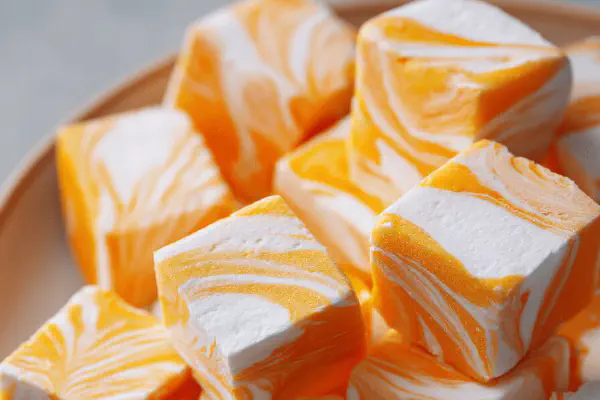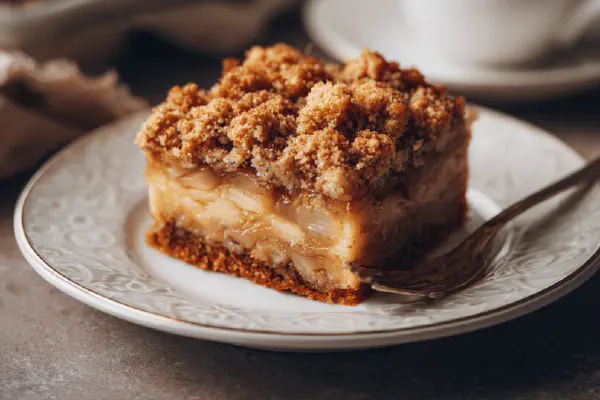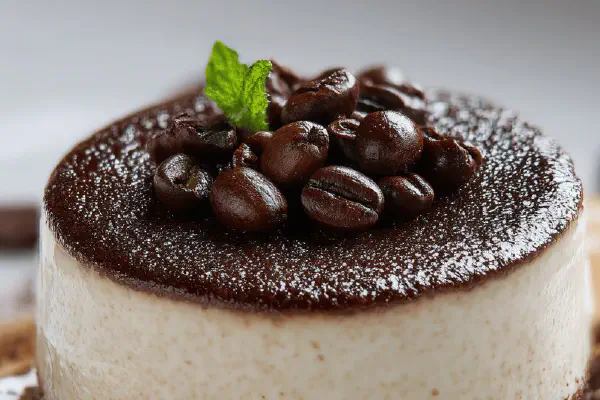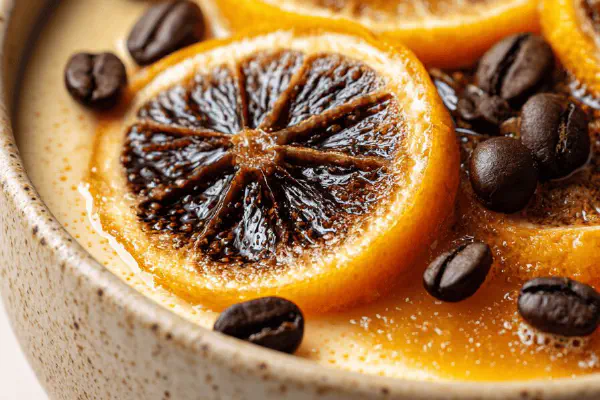Vanilla Panna Cotta Rhubarb Compote
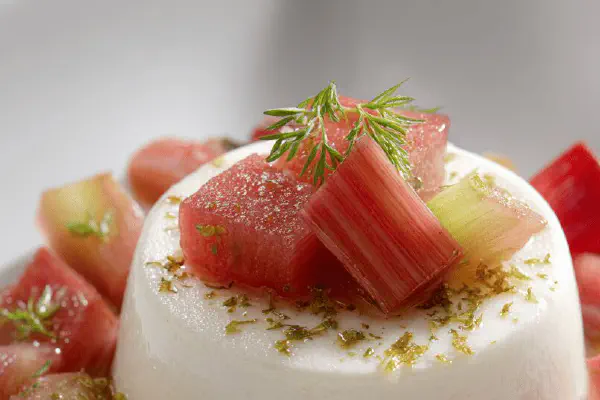
E
By Emma
Certified Culinary Professional
•
Recipe tested & approved
Silky vanilla panna cotta set gently with gelatin, paired with tart rhubarb compote simmered down until translucent and tender. Uses authentic vanilla pods for depth. Substitutes agar-agar for gelatin when needed. Techniques focus on sensory clues like aroma and texture over rigid timing. Notes on ramequin prep prevent sticking. Rhubarb cooked down to velvet softness, balanced with sugar, finished chilled for contrast. Builds familiarity with proper swelling of gelatin, infusion of vanilla, and timing compote reduction. Practical tips addressing common slip-ups like grainy custard or overcooked rhubarb. A classic dessert with a nuanced twist, approachable with everyday pantry staples and intuitive workflow.
Prep:
22 min
Cook:
14 min
Total:
36 min
Servings:
6 servings
#dessert
#French-inspired
#gelatin
#vanilla
#rhubarb
#compote
#cooking tips
Panna cotta starting from the gelatin bloom stage. Avoid rushing; that gelatin swelling is an old-school indicator I trust over timers. Vanilla pods cracked open, seeds scraped—no cutting corners here. The scent hitting air as cream warms is subtle but unmistakable. Simmer, never boil; look for tiny bubbles hugging pan edges. No missed sugar crystals—soft whisking’s key. Pour into oiled ramekins; those slippery sides pay off during unmolding. The compote isn’t just rhubarb and sugar boiled down—it’s a delicate balancing act, cooking till rhubarb just turns translucent, keeping a bit of tooth. Chill compote well to thicken and sharpen flavors. Timing’s flexible; trust texture cues. Serve chilled panna cotta with tart rhubarb spooned on — temperature contrast gives punch. Tried it with agar-agar once; texture firmer, less forgiving. Keep it gentle, sensory-driven. Experience tells everything.
Ingredients
- 11 ml (2 ⅓ tsp) gelatin powder
- 50 ml (3 ½ tbsp) cold water
- 2 whole vanilla pods split and seeds scraped
- 400 ml (1 ⅔ cups) 35% heavy cream
- 130 ml (½ cup plus 2 tbsp) whole milk
- 80 ml (⅓ cup plus 1 tbsp) granulated sugar
- 400 ml (1 ⅔ cups) fresh or frozen chopped rhubarb
- 135 ml (⅔ cup) granulated sugar
- 35 ml (2 ½ tbsp) water
About the ingredients
Gelatin’s bloom time indicative of freshness; don’t shortchange or panna cotta sets weak. Vanilla pods expensive but essential for true aroma and those black seeds speak quality—extracts can fill but lose nuance. Heavy cream richness paramount—don’t swap cream for milk entirely unless counting calories; custard suffers in silkiness. Milk added softens richness, balances mouthfeel. Sugar adjusted for sweetness preference; slightly more sugar easier to balance rhubarb tartness. Rhubarb can be fresh or frozen; frozen needs brief thaw before use to maintain even cooking. Water amount in compote crucial; too much turns it watery, too little burns rhubarb. Better add gradually if uncertain. Oils for ramekins neutral—coconut or canola work. Plastic wrap on top of cold custard avoids skin, a common failure point.
Method
Vanilla Panna Cotta Preparation
- Bloom gelatin in cold water. Let sit until soft and jiggles when shaken, about 6 minutes. The gelatin swelling tells you if quality is good; old gelatin won’t swell properly, uses moisture as a test.
- Split pods, scrape seeds. Don’t discard pods yet; steep them along with seeds for max flavor. Vanilla’s smoky aroma starts to fill the kitchen at this step; keep heat low to avoid scorching cream.
- Heat cream, milk, sugar, vanilla seeds and pods over medium-low. Stir gently so sugar dissolves. Watch closely—once near simmer, bubbles form around edges with faint steam aroma, time to remove promptly. Overheating dulls flavors, no more than 10-12 mins here.
- Remove pods carefully to avoid bitterness. Whisk in softened gelatin fully; absence of grains is key. Passing through a fine sieve catches stray bits and pod fragments, making texture satin smooth. I always do this—worth extra step.
- Prepare six 130 ml ramekins: lightly oil with neutral oil or quick wet rinse and drain, leaving some moisture to help release panna cotta after chilling. Avoid drying after rinsing, or it sticks hard.
- Pour warm mixture evenly. Cover surfaces with plastic wrap touching custard to prevent skin forming. Refrigerate undisturbed at least 5 ½ hours; if rushed, overnight is best to ensure firm but tender set.
Rhubarb Compote
- Combine rhubarb, sugar and water in small saucepan. Bring to gentle boil over medium heat. Stir often. Rhubarb breaks down releasing a sharp tang and faint floral note—roasting the aroma in pan while stirring helps gauge doneness.
- Simmer until rhubarb pieces start to dissolve and translucence appears, about 6 minutes; timing can shift depending on fresh or frozen state and stalk thickness. Shouldn’t be watery, but not a thick jam either; soft with some texture remaining.
- Remove from heat; cool to room temp then chill at least 2 ½ hours, allowing flavors to meld and texture to thicken slightly. Keep in fridge uncovered or lightly covered with cloth so excess moisture doesn’t pool.
- To serve, gently unmold panna cotta by loosening edges with thin knife if needed. Invert ramekin onto serving plate, maybe dipped quickly in warm water for 3-5 seconds beforehand to ease release without melting custard.
- Spoon portion of compote on or beside panna cotta. Contrast in temperature, texture, and tartness makes mouth dance.
Notes and Substitutions
- Agar-agar can replace gelatin but requires boiling to activate; add half a teaspoon dissolved in water and bring to simmer with cream mixture. Texture will be more firm, less wobbly. Adjust as your preferences.
- Using vanilla extract instead of pods is acceptable; add with cream before heating, but intensity differs. Pods impart a richer, more complex aroma and visible black specs that mean flavor.
- If cream too cold or gelatin added too hot, gelatin can clump. Temper gelatin by whisking some hot cream first before folding all in. Avoid stirring vigorously once gelatin added—too much air creates bubbles.
- If panna cotta is runny after set time, gelatin wasn’t fully dissolved or bloom time too short. Let it sit longer or reheat gently and add extra gelatin dissolved separately.
- Rhubarb flavor varies by season. If overly tart, increase sugar by tablespoon increments. If too sweet, add lemon zest to brightness. Can mix in orange blossom water or cardamom for seasonal twist.
- To speed compote, chop rhubarb finely, but texture changes. Larger pieces hold shape giving pleasant contrast.
- Serve panna cotta straight from fridge for pure texture; avoid letting sit out too long, or it becomes almost custard-like and difficult to unmold cleanly.
Cooking tips
Bloom gelatin first; it’s the backbone of smooth texture—negligence causes lumps. Heating cream with vanilla pods infuses aroma effectively; keep heat low to preserve fragrance. Use gentle stirring to avoid aeration which yields bubbles. Strain for silkiness; skipping this traps bits and ruins mouthfeel. Ramekin prep overlooked, but essential to ease unmolding; dry ramekins cause frustration and ugly breaks. Chill long enough—6 hours minimum but overnight preferred. For compote, start with medium heat; boiling too hard breaks structure, tastes harsh. Listen for soft rhubarb breaking down, watch translucency as doneness guide. Cool fully before fridge—hot compote in fridge causes condensation issues and dilutes flavor. Serving requires patience; rushing causes cracks or melting mishaps. Clean edges with sharp knife, unmold with quick warm water dip if needed. Best combined just before eating to keep contrasts vibrant.
Chef's notes
- 💡 Bloom gelatin first. Gelatin lumps mean bloom failed - key for satin texture. Use cold water, watch gelatin jiggle to confirm readiness. Old gelatin won’t swell properly, test freshness every batch.
- 💡 Steep vanilla pods with seeds. Don’t toss pods early; flavor loss is subtle but real. Low heat only - cream can scorch, smell changes quick. That smoky hint before simmering is your sensory cue.
- 💡 Heat cream and milk mix gently. Watch for tiny bubbles on pan edges, faint steam aroma - signals close to temp. Overheat dulls cream richness and flattens vanilla notes. Ten to twelve minutes max.
- 💡 Strain custard after adding gelatin. Pod bits ruin mouthfeel, trapped grittiness kills silkiness. Use fine sieve. Worth extra effort for silky texture. Skip strain and grains linger.
- 💡 Prep ramekins with neutral oil or wet rinse; moisture helps releasing panna cotta later. Dry ramekins stick. Oil thin and even; too much oil creates slick mess or pooled custard edges.
- 💡 Chill panna cotta undisturbed minimum 6 hours, overnight preferred. Skin forms fast; plastic wrap pressed on custard stops that. Rushing mean weak set or grainy texture. Patience = stable jiggly dessert.
- 💡 Simmer rhubarb softly. Medium heat only; boiling hard breaks fruit completely, harsh flavor. Rhubarb translucent, pieces still hold shape. Texture balance key, no water puddles, no thick jam.
- 💡 Cool compote before fridge. Hot compote in fridge causes moisture condensation, dilutes flavor and softens texture. Leave uncovered or cover lightly with cloth to avoid pooling water.
- 💡 Swap gelatin for agar-agar carefully. Agar needs boiling, sets firmer, less wobbly. Dissolve half teaspoon first. Adjust firmness by varying agar amount. Agar not gelatin equal replacement.
- 💡 If panna cotta is runny, bloom or dissolving failed. Gelatin clumps means heat too high, add gelatin carefully, maybe temper with hot cream first. Reheat gently to fix or boost gelatin quantity.
Common questions
How to know gelatin bloom is good?
Gelatin softens, jiggles, swells in cold water. Old gelatin won’t swell, stays powdery or lumps. Test each batch. Without bloom, custard won’t set cleanly.
Can vanilla extract replace pods?
Extract works, add with cream before heating. Flavor milder, no black specks visual cue. Pods give richer aroma, smoky notes during gentle simmer. Choose based on preference.
What if compote too tart or sweet?
Add sugar slowly up to preference or lemon zest for brightness. Orange blossom water or cardamom add complexity. Chop size affects texture; smaller for speed but less bite.
How to store panna cotta and compote?
Keep panna cotta covered in fridge at least 5 hours, ideally overnight. Compote stored chilled, loosely covered to avoid moisture build-up. Serve chilled for best texture contrast.
